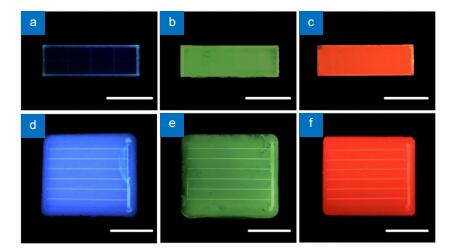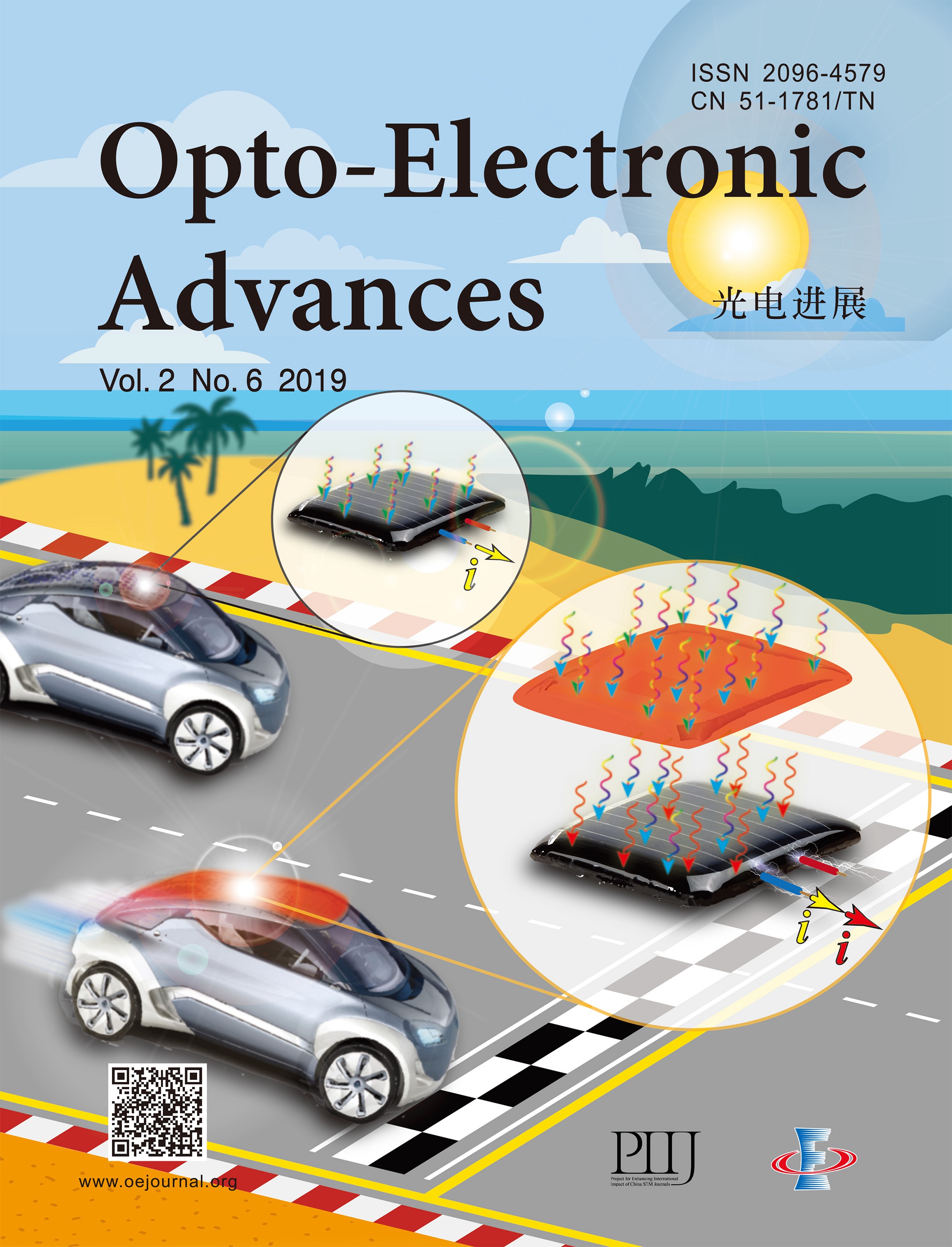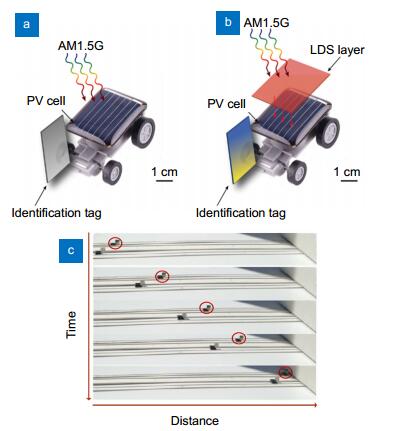| Citation: | Sandra F. H. Correia, Ana R. N. Bastos, Lianshe Fu, et al. Lanthanide-based downshifting layers tested in a solar car race. Opto‐Electron Adv 2, 190006 (2019). doi: 10.29026/oea.2019.190006 |
Original Article Open Access
Lanthanide-based downshifting layers tested in a solar car race
-
Abstract
The mismatch between the AM1.5G spectrum and the photovoltaic (PV) cells absorption is one of the most limiting factors for PV performance. To overcome this constraint through the enhancement of solar energy harvesting, luminescent downshifting (LDS) layers are very promising to shape the incident sunlight and, thus, we report here the use of Tb3+- and Eu3+-doped organic-inorganic hybrid materials as LDS layers on Si PV cells. Electrical measurements on the PV cell, done before and after the deposition of the LDS layers, confirm the positive effect of the coatings on the cell's performance in the UV spectral region. The maximum delivered power and the maximum absolute external quantum efficiency increased 14% and 27%, respectively. Moreover, a solar powered car race was organized in which the small vehicle containing the coated PV cells presented a relative increase of 9% in the velocity, when compared to that with the uncoated one.-
Keywords:
- photovoltaics /
- downshifting layers /
- solar car /
- organic-inorganic hybrids /
- lanthanide ions
-

-
References
[1] Nann S, Riordan C. Solar Spectral irradiance under clear and cloudy skies: measurements and a semiempirical model. J Appl Meteorol 30, 447-462 (1991). doi: 10.1175/1520-0450(1991)030<0447:SSIUCA>2.0.CO;2 [2] Shimokawa R, Miyake Y, Nakanishi Y, Kuwano Y, Hamakawa Y. Effect of atmospheric parameters on solar cell performance under global irradiance. Sol Cells 19, 59-72 (1986). doi: 10.1016/0379-6787(86)90050-5 [3] Alboteanu I, Bulucea C, Degeratu S. Estimating solar irradiation absorbed by photovoltaic panels with low concentration located in Craiova, Romania. Sustainability 7, 2644-2661 (2015). doi: 10.3390/su7032644 [4] Huang X, Han S, Huang W, Liu X. Enhancing solar cell efficiency: the search for luminescent materials as spectral converters. Chem Soc Rev 42, 173-201 (2013). doi: 10.1039/C2CS35288E [5] Bünzli J-C G, Chauvin A-S. Handbook on the Physics and Chemistry of Rare-Earths (Elsevier B. V., Amsterdam), 169-281 (2014). [6] Ho W-J, Deng Y-J, Liu J-J, Feng S-K, Lin J-C et al. Photovoltaic performance characterization of textured silicon solar cells using luminescent down-shifting Eu-doped phosphor particles of various dimensions. Materials10, 21 (2017). doi: 10.3390/ma10010021 [7] Ho W-J, You B-J, Liu J-J, Bai W-B, Syu H-J et al. Photovoltaic performance enhancement of silicon solar cells based on combined ratios of three species of Europium-doped phosphors. Materials 11, 845 (2018). doi: 10.3390/ma11050845 [8] Ho W-J, Feng S-K, Liu J-J, Yang Y-C, Ho C-H. Improving photovoltaic performance of silicon solar cells using a combination of plasmonic and luminescent downshifting effects. Appl Surf Sci 439, 868-875 (2018). doi: 10.1016/j.apsusc.2017.12.232 [9] Klampaftis E, Ross D, McIntosh K R, Richards B S. Enhancing the performance of solar cells via luminescent down-shifting of the incident spectrum: A review. Sol Energy Mater Sol Cells 93, 1182-1194 (2009). doi: 10.1016/j.solmat.2009.02.020 [10] Klampaftis E, Richards B S. Improvement in multi-crystalline silicon solar cell efficiency via addition of luminescent material to EVA encapsulation layer. Prog Photovoltaics Res Appl 19, 345-351 (2011). doi: 10.1002/pip.1019 [11] Kataoka H, Omagari S, Nakanishi T, Hasegawa Y. EVA thin film with thermo- and moisture-stable luminescent copolymer beads composed of Eu(Ⅲ) complexes for improvement of energy conversion efficiency on silicon solar cell. Opt Mater42, 411-416 (2015). doi: 10.1016/j.optmat.2015.01.038 [12] Ho W-J, Shen Y-T, Liu J-J, You B-J, Ho C-H et al. Enhancing photovoltaic performance using broadband luminescent down-shifting by combining multiple species of Eu-soped silicate phosphors. Nanomaterials 7, 340 (2017). doi: 10.3390/nano7100340 [13] Liu J, Wang K, Zheng W, Huang W, Li C H et al. Improving spectral response of monocrystalline silicon photovoltaic modules using high efficient luminescent down-shifting Eu3+ complexes. Prog Photovoltaics 21, 668-675 (2013). doi: 10.1002/pip.1251 [14] Monzón-Hierro T, Sanchiz J, González-Pérez S, González-Díaz B, Holinski S et al. A new cost-effective polymeric film containing an Eu(Ⅲ) complex acting as UV protector and down-converter for Si-based solar cells and modules.Sol Energy Mater Sol Cells 136, 187-192 (2015). doi: 10.1016/j.solmat.2015.01.020 [15] Le Donne A, Acciarri M, Narducci D, Marchionna S, Binetti S. Encapsulating Eu3+ complex doped layers to improve Si-based solar cell efficiency. Prog Photovoltaics 17, 519-525 (2011). [16] Le Donne A, Dilda M, Crippa M, Acciarri M, Binetti S. Rare earth organic complexes as down-shifters to improve Si-based solar cell efficiency. Opt Mater 33, 1012-1014 (2011). doi: 10.1016/j.optmat.2010.10.005 [17] González-Pérez S, Sanchiz J, González-Díaz B, Holinski S, Borchert D et al. Luminescent polymeric film containing an Eu(Ⅲ) complex acting as UV protector and down-converter for Si-based solar cells and modules. Surf Coatings Technol 271, 106-111 (2015). doi: 10.1016/j.surfcoat.2014.12.074 [18] Kin E, Fukuda T, Yamauchi S, Honda Z, Ohara H et al. Thermal stability of europium(Ⅲ) chelate encapsulated by sol-gel glass. J Alloys Compd 480, 908-911 (2009). doi: 10.1016/j.jallcom.2009.02.063 [19] Fix T, Nonat A, Imbert D, Di Pietro S, Mazzanti M et al. Enhancement of silicon solar cells by downshifting with Eu and Tb coordination complexes. Prog Photovoltaics Res Appl 24, 1251-1260 (2016). doi: 10.1002/pip.v24.9 [20] Yang Y, Zhang S. Study of lanthanide complexes with salicylic acid by photoacoustic and fluorescence spectroscopy. Spectrochim Acta Part A Mol Biomol Spectrosc 60, 2065-2069 (2004). doi: 10.1016/j.saa.2003.11.005 [21] Wu R, Zhao H, Su Q. Photoacoustic and fluorescence studies of silica gels doped with rare earth salicylic acid complexes. J Non-Cryst Solids 278, 223-227 (2000). doi: 10.1016/S0022-3093(00)00309-4 [22] Misra V, Mishra H. Photoinduced proton transfer coupled with energy transfer: Mechanism of sensitized luminescence of terbium ion by salicylic acid doped in polymer. J Chem Phys 128, 244701 (2008). doi: 10.1063/1.2918284 [23] Li S W, Song H W, Li W L, Ren X G, Lu S Z et al. Improved photoluminescence properties of ternary terbium complexes in mesoporous molecule sieves. J Phys Chem B 110, 23164-23169 (2006). doi: 10.1021/jp064509d [24] Fan X, Wang Z, Wang M. In situ synthesis kinetics of salicylicscid terbium complexes in sol-gel derived host materials. J Sol-Gel Sci Technol 30, 95-99 (2004). doi: 10.1023/B:JSST.0000034697.17767.96 [25] de Zea Bermudez V, Carlos L D, Alcácer L. Sol-gel derived urea cross-linked organically modified silicates. 1. Room temperature mid-infrared spectra. Chem Mater 11, 569-580 (1999). doi: 10.1021/cm980372v [26] Molina C, Dahmouche K, Messaddeq Y, Ribeiro S J L, Silva M A P et al. Enhanced emission from Eu(Ⅲ) β-diketone complex combined with ether-type oxygen atoms of di-ureasil organic-inorganic hybrids. J Lumin 104, 93-101 (2003). doi: 10.1016/S0022-2313(02)00684-1 [27] Correia S F H, Lima P P, Pecoraro E, Ribeiro S J L, André P S et al. Scale up the collection area of luminescent solar concentrators towards metre-length flexible waveguiding photovoltaics. Prog Photovoltaics Res Appl24, 1178-1193 (2016). doi: 10.1002/pip.v24.9 [28] Correia S F H, Frias A R, Fu L, Rondão R, Pecoraro E et al. Large-area tunable visible-to-near-infrared luminescent solar concentrators. Adv Sustain Syst 2, 1800002 (2018). doi: 10.1002/adsu.v2.6 [29] Correia S F H, Lima P P, André P S, Ferreira R A S, Carlos L D. High-efficiency luminescent solar concentrators for flexible waveguiding photovoltaics. Sol Energy Mater Sol Cells 138, 51-57 (2015). doi: 10.1016/j.solmat.2015.02.032 [30] Freitas V T, Lima P P, Ferreira R A S, Pecoraro E, Fernandes M et al. Luminescent urea cross-linked tripodal siloxane-based hybrids. J Sol-Gel Sci Technol 65, 83-92 (2013). doi: 10.1007/s10971-012-2770-2 [31] Carlos L D, de Zea Bermudez V, Ferreira R A S, Marques L, Assunção M. Sol-gel derived urea cross-linked organically modified silicates. 2. Blue-light emission.Chem Mater 11, 581-588 (1999). doi: 10.1021/cm980373n [32] Nolasco M M, Vaz P M, Freitas V T, Lima P P, André P S et al. Engineering highly efficient Eu(Ⅲ)-based tri-ureasil hybrids toward luminescent solar concentrators. J Mater Chem A 1, 7339-7350 (2013). doi: 10.1039/c3ta11463e [33] Kai J A, Felinto M C F C, Nunes L A O, Malta O L, Brito H F. Intermolecular energy transfer and photostability of luminescence-tuneable multicolour PMMA films doped with lanthanide-beta-diketonate complexes. J Mater Chem 21, 3796-3802 (2011). doi: 10.1039/c0jm03474f [34] Fernandes M, de Zea Bermudez V, Ferreira R A S, Carlos L D, Charas A et al. Highly photostable luminescent poly (E-caprolactone) siloxane biohybrids doped with europium complexes. Chem Mater 19, 3892-3901 (2007). doi: 10.1021/cm062832n [35] Reisfeld R, Shamrakov D, Jorgensen C. Photostable solar concentrators based on fluorescent glass-films. Sol Energy Mater Sol Cells 33, 417-427 (1994). doi: 10.1016/0927-0248(94)90002-7 [36] Rondão R, Frias A R, Correia S F H, Fu L, de Zea Bermudez V et al. High-performance near-infrared luminescent solar concentrators. ACS Appl Mater Interfaces 9, 12540-12546 (2017). doi: 10.1021/acsami.7b02700 [37] Gai Y, Jiang F, Chen L, Wu M, Su K et al. Europium and terbium coordination polymers assembled from hexacarboxylate ligands: structures and luminescent properties. Cryst Growth Des 14, 1010-1017 (2014). doi: 10.1021/cg401452p [38] Graffion J, Cojocariu A M, Cattoeen X, Ferreira R A S, Fernandes V R et al. Luminescent coatings from bipyridine-based bridged silsesquioxanes containing Eu3+ and Tb3+ salts. J Mater Chem 22, 13279-13285 (2012). doi: 10.1039/c2jm31289a [39] Lima P P, Ferreira R A S, Alves Junior S, Malta O L, Carlos L D. Terbium(Ⅲ)-containing organic-inorganic hybrids synthesized through hydrochloric acid catalysis. J Photochem Photobiol A-Chemistry 201, 214-221 (2009). doi: 10.1016/j.jphotochem.2008.10.021 [40] Mahadik D B, Lakshmi R V, Barshilia H C. High performance single layer nano-porous antireflection coatings on glass by sol-gel process for solar energy applications. Sol Energy Mater Sol Cells 140, 61-68 (2015). doi: 10.1016/j.solmat.2015.03.023 [41] Preston C, Xu Y L, Han X G, Munday J N, Hu L B. Optical haze of transparent and conductive silver nanowire films. Nano Res 6, 461-468 (2013). doi: 10.1007/s12274-013-0323-9 [42] Griffini G, Bella F, Nisic F, Dragonetti C, Roberto D et al. Multifunctional luminescent down-shifting fluoropolymer coatings: a straightforward strategy to improve the UV-light harvesting ability and long-term outdoor stability of organic dye-sensitized solar cells. Adv Energy Mater 5, 1401312 (2015). doi: 10.1002/aenm.201401312 [43] Bin Hung W, Chen J Y, Sung K W, Chen T M. Enhanced conversion efficiency of crystalline Si solar cells via luminescent down-shifting using Ba2SiO4:Eu2+ phosphor. J Ceram Process Res 15, 157-161 (2014). [44] Chen J-Y, Huang C K, Hung W B, Sun K W, Chen T M. Efficiency improvement of Si solar cells using metal-enhanced nanophosphor fluorescence. Sol Energy Mater Sol Cells 120, 168-174 (2014). doi: 10.1016/j.solmat.2013.08.039 [45] Liu J F, Yao Q H, Li Y D. Effects of downconversion luminescent film in dye-sensitized solar cells. Appl Phys Lett 88, 173119 (2006). doi: 10.1063/1.2198825 -
Supplementary Information
Supplementary information for Lanthanide-based downshifting layers tested in a solar car race 
video.mp4 
-
Access History

Article Metrics
- Figure 1. Photographs of the (a, d) bare PV devices and of the coated (b, c) PV-1 and (e, f) PV-2 with the (b, e) dU6-Tb and (c, f) tU5-Eu LDS layers, under UV radiation at 365 nm.
- Figure 2. (a) Excitation spectra (dashed lines) monitored at 543 nm and 615 nm for dU6-Tb (green line) and tU5-Eu (red line), respectively, and emission spectra (solid lines) excited at 315 nm for dU6-Tb (green line), and 365 nm for tU5-Eu (red line); (b) Absorption spectra of dU6-Tb and tU5-Eu and AM1.5G photon flux (right y axis). The shadowed areas represent the overlap integral, Eq. (3), with the same colour code as the excitation and emission spectra.
- Figure 3. Total (solid lines) and diffuse (dashed lines) reflectance of (a) PV-1 and (b) PV-2 with dU6-Tb (green lines) and tU5-Eu (red lines) coatings compared with the average reflectance curve measured for distinct bare PV devices (black lines).
- Figure 4. EQE curves of (a) PV-1 and (b) PV-2 with dU6-Tb (green dotted lines) and tU5-Eu (red solid lines) coatings compared with the correspondent bare PV devices (black lines).
- Figure 5. V-P curves of (a) PV-1 and (b) PV-2 with dU6-Tb (green dotted lines) and tU5-Eu (red solid lines) coatings compared with the correspondent bare PV devices (black lines).
- Figure 6. Scheme of the solar vehicle with (a) bare PV-2 and (b) PV-2 with the LDS coating and (c) photographs of the solar vehicles race. The solar vehicle with the coated PV cell is indicated by the red circle.

 E-mail Alert
E-mail Alert RSS
RSS



 DownLoad:
DownLoad:







